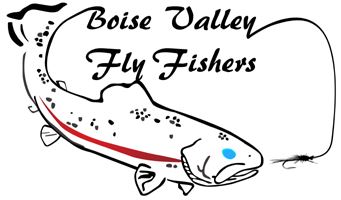Dave’s Strategy Session
by Dave Shuldes, shuldesd@gmail.com

The Arctic Grayling Challenge
One of many challenges that Boise Valley Fly Fishers offers to our members each year is the Idaho Arctic Grayling club. Details are listed at this link: Idaho Arctic Grayling Challenge.
There are currently 9 BVFF Grayling Club members, including Mike Mclean, Tom Old, Tim Old and George Butts from 2019-2023. At our BVFF club meeting in March, Jim Kazakoff recognized the new 2024 additions including Patti Bantam, Jill Bradley, Greg Hitchcock, Johnny Rogers and Lisa Szentes. Congratulations to all!
In short, the challenge is to catch, photograph and release an Arctic Grayling in Idaho. These beautiful fish with their neon blue sail fins are planted by the Idaho Department of Fish & Game (IDFG) in Alpine lakes throughout the state. Stocking locations and schedule can be found here:
- Where have Arctic Grayling been stocked by IDF&G LINK
- Where have Arctic Grayling been observed in SW Idaho LINK
A tip for our statewide members; the search linked above was set for SW Idaho. You will note that you can check off all the regions of the state you are interested in to expand the results for your area of interest.
During our planning for our annual backpacking trips, my hiking partners and I often research the stocking schedule for our destinations so we know what to expect. The Frank Church Wilderness, McCall area and Sawtooth Mountains  are all good targets. These lakes are usually quite remote, so we often schedule an initial day to pack in and establish a base camp, then day hike to the lakes, which may contain Grayling and other uncommon species, such as Golden Trout and or Tiger Trout. Once established these species can over winter for years in the same high elevation lakes. Many of these lakes are unnamed and can only be referenced by their altitude.
are all good targets. These lakes are usually quite remote, so we often schedule an initial day to pack in and establish a base camp, then day hike to the lakes, which may contain Grayling and other uncommon species, such as Golden Trout and or Tiger Trout. Once established these species can over winter for years in the same high elevation lakes. Many of these lakes are unnamed and can only be referenced by their altitude.
Finding the location of Grayling is the key. Once you’ve found your target, the fishing strategy is similar to alpine lakes cutthroat and rainbows. I use a four or five weight rod, floating or sink tip line, a 9 foot leader and 4X or 5X tippet. My favorite fly patterns are a Gartside Sparrow pattern customized with black Krystal Flash in the tail and pointing toward the hook tip from the eye, or a customized Prince Nymph with olive brown goose biots. Hook size is #10, 2X long. I start with a 3 or 4mm tungsten bead head in bronze or olive, and finish with a subtle collar of red thread just behind the bead.
In the right conditions (generally low to no wind) Arctic Grayling will also feed readily on surface flies. A #14 or #16 Elk Hair Caddis, Renegade, or Flying Ant pattern will usually do the trick. When casting, I generally seek out deeper water. Underneath deep ledges and pockets behind boulders are common hangouts.
These Grayling, living in pristine water conditions, will live for many years if treated well. Use of barbless hooks and photographing the fish while they remain in the water are strongly recommended. Catching these relatively rare, colorful species in our Alpine lakes are one of the many delights of fishing in Idaho. There are relatively few places throughout the US and around the world where the right combination of wilderness preservation and wildlife management provide us with these fishing opportunities. We are very lucky to live in such a beautiful state!
the fish while they remain in the water are strongly recommended. Catching these relatively rare, colorful species in our Alpine lakes are one of the many delights of fishing in Idaho. There are relatively few places throughout the US and around the world where the right combination of wilderness preservation and wildlife management provide us with these fishing opportunities. We are very lucky to live in such a beautiful state!
Always bring the 10 essentials, travel with a partner, and be prepared for extreme changes in weather at these altitudes which often exceed 8,000 feet in elevation. Tight lines & good luck with the Grayling challenge!
Idaho Arctic Grayling Challenge

